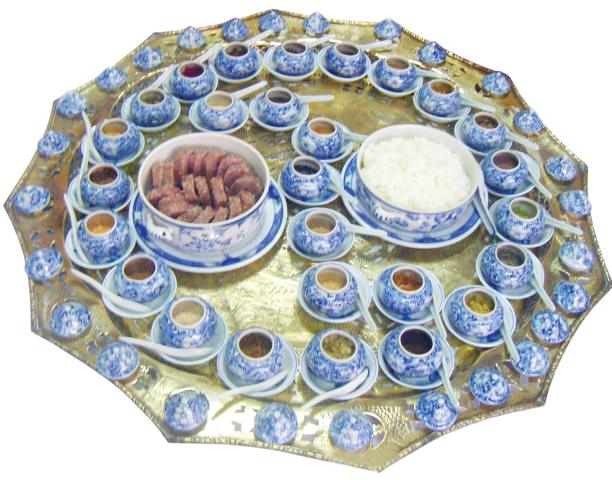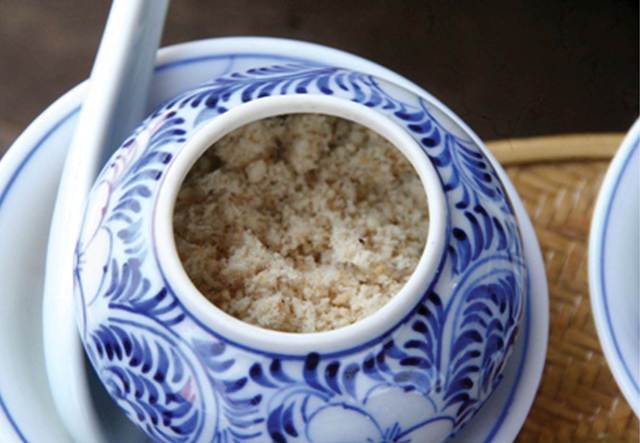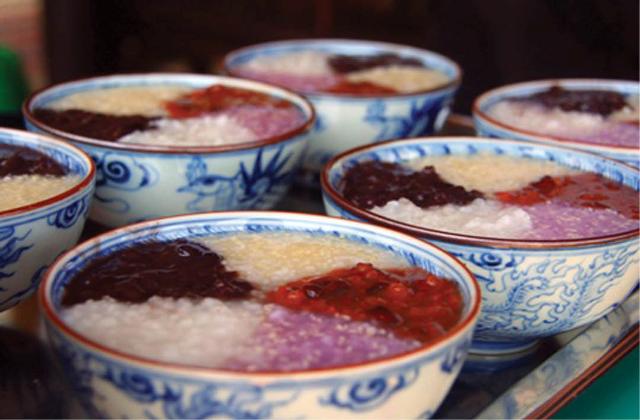
Salt dishes by Chef Đặng Văn Sơn (Photo provided by the author)
Cooking as art
Before the meal, the artisan Ton Nu Thi Ha introduced: "Ladies and gentlemen, you are going to taste 36 salt dishes including: chili salt, pickle salt, ginger salt, mackerel salt, tuna salt, beef salt, pork salt, etc. The dishes sound simple, but they show the philosophy of sufficiency of Vietnamese people, recalling the time of clearance and the struggle against the harsh weather. In Hue, many dishes popular with common people entered the court and became royal dishes. Salt dishes are a balance of protein, fat and sugar. Eating salt dishes, one needs to chew slowly, which is good for digestion.
At first, I was thinking about the popular and cheap salt dishes with peanut, sesame, lemongrass, etc. But no, enjoying a meal of salt dishes as depicted by the writer Nguyen Tuan is a chance of a lifetime. Many Hue culture researchers have listed salt dishes as the first-class dishes of the Nguyen Dynasty. For visitors to Hue, tasting a meal of salt dishes is really a privilege.

Tuna salt (Photo: Dai Duong)
One of the few chefs in Hue who can "remake" a salt feast is Dang Van Son. According to him, to prepare a salt dish, the salt must be the kind which feels sandy on the tip of the tongue but tastes sweet in the throat. It is the salt that was cooked in a pottery pot at high temperature until it evaporated then condensed into coarse, white particles. The longer it is kept, the better. To make mackerel salt for example, the fish is steamed then pounded with care before being added to the salt. Cook the mixture slowly over a small fire so that the ingredients mix well. It takes about two hours of constantly stirring. To prepare a 9-course meal, or 12-course, or more, it is an art of cooking and displaying.
Hue salt dishes are divided into 3 groups with tens of different dishes. The vegetarian group consists of salt with sesame, peanut, pepper, chili, apricot, lime, etc.; the fish group with mackerel, field anabas, goby, scad, etc.; the meat group includes with pork, beef, chicken, goat meat, etc. The salt dishes contain all the flavors: bitter, hot, sour, sweet, fatty. Boiled rice to accompany must be from gao de, the rice grown on An Cuu field which used to be served to the king in the old days. Rice must be cooked in pots made in Phuoc Tich Village, ensuring the rice is soft but still in shape, dry but not hard.
Y Thao Restaurant is among the few restaurants that serve a complete menu of salt dishes like one in the past. The restaurant owner said each salt dish must accompany a different kind of food. Plain salt goes with five-colored porridge; peanut and sesame are eaten with sticky rice; meat and fish salt are eaten with boiled rice, etc. People who enjoy salt dishes will obtain a balance of yin and yang. Salt dishes become food for health. A researcher told me that eating salt dishes means "eating" the culture of Hue. One should chew slowly, a bit at a time to enjoy the delicious, sweet taste. Hue salt dishes are unique. Preparing a salt feast is an art, only found in Hue. For Hue people, eating salt dishes is to contemplate, not just to know.
Bringing salt dishes to tourists
Because salt dishes require meticulous cooking and represent the typical culture of the ancient capital, few people can make them and few have chances to taste them. As a result, salt meal is really an tourist attraction. Consumers should know that salt dishes are not for everyone and one hence must eat them with manners.

Salt feast with five-colored porridge (Photo: Dai Duong)
It would be shocking to learn that a salt meal may cost up to VND 3-4 million. In return, tourists can "eat" the profound culture of Hue. Tinh Gia Vien Restaurant has restored the salt feast for tourists a couple of times. The owner of the restaurant said that the demand for this is real. However, in order to become a tourist product, it needs to be renewed all the time. Tour makers should promote cuisine in general and the salt meal in particular. The popularity of salt dishes is still low, which is both strong and weak points. The salt meal is royal cuisine; it needs delicacy. Those who really love Hue will love the salt meal, and its high price will not be a problem for them.
From old materials, the artisan Hoang Thi Nhu Huy restored and developed new salt dishes. The Cuisine Culture Association of Vietnam is collaborating with Nhu Huy to prepare for the nomination of salt dishes to become a world heritage. If successful, the way for the salt meal to convince visitors would be shorter. Those who have never tasted salt dishes, do come to visit Hue.
Depending on the season, the chef will adjust the amount of salt in salt dishes so that the body can absorb a balance of yin and yang, cold and hot. Hot, salty and "sweet" salt dishes suit rainy days while salt dishes with bitter and sour tastes suit summer.
Story: DUC QUANG